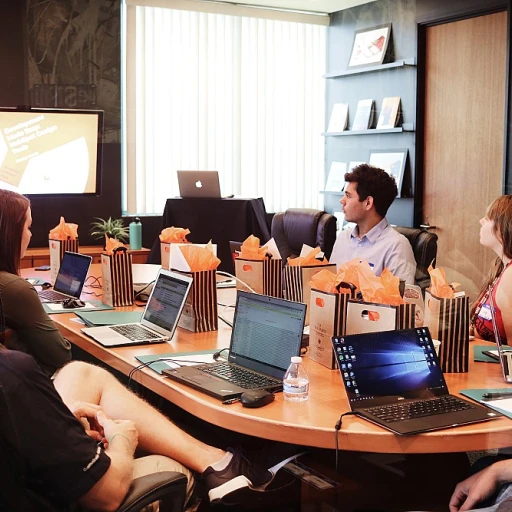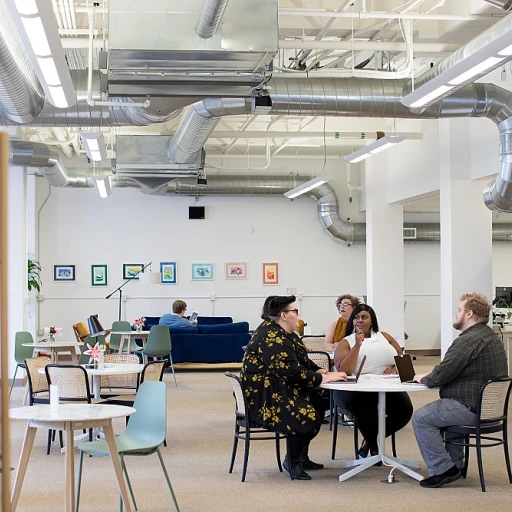
Understanding the Role of CHRO in Enterprise Agility
The Strategic Role of HR in Driving Agile Transformation
The Chief Human Resources Officer (CHRO) plays a pivotal role in steering an organization's journey toward agility. As enterprises increasingly venture into agile adaptations, the CHRO's strategic insight becomes vital in embedding these changes seamlessly into the core operations. In today’s ever-evolving business landscape, this transition is crucial not only for survival but for sustainable success. The strategic realignment of HR processes and fostering a flexible workforce are foundational steps. Developed capabilities within HR practices, such as implementing agile methodologies, empower teams and promote a smoother transformation throughout the company. This, in turn, directly benefits the organization's agility and fosters enterprise-wide adaptation to the rapidly changing market demands. To address these evolving needs, organizations must integrate cross-functional teams that encourage collaboration and real-time solutions. This approach aligns with the promotion of continuous improvement practices, leveraging HR to enhance performance and facilitate accelerated change. This ensures that every employee's experience is enriched and that engagement levels remain high, ultimately contributing to superior customer satisfaction. As highlighted by industry leaders like PwC, adapting to an agile model demands a unique operational approach. This involves redefining the company’s operating model by embracing agile practices that encompass cultural transformation efforts, robust team structures, and advanced technology utilization. Such a transformable model ensures that HR is not only responsive but also proactively orchestrates organizational change. Moreover, measuring performance metrics and sustaining agility across the enterprise must be prioritized. By utilizing integrated technologies, HR can efficiently monitor and analyze agility metrics, thus reinforcing the company's agility enterprises. Featured insights from successful agile organizations reveal that these changes are instrumental in maintaining competitive advantage and fostering an environment that thrives on agility and innovation. By focusing on real-time adjustments and continuous evaluation, agile organizations can swiftly capitalize on new opportunities and sustain growth.Building a Flexible Workforce
Fostering Adaptability for a Dynamic Workforce
In today's rapidly evolving business landscape, enterprises must prioritize building a flexible workforce to enhance business agility. A dynamic workforce capable of adapting to changing conditions is crucial for maintaining competitive advantage and driving success. Organizations can achieve this by investing in strategies that promote employee engagement and capability development. To establish an adaptable workforce, consider the following:- Cross-Functional Collaboration: Encourage employees to work across various functional teams, allowing them to diversify their skills and gain broader experience. This cross-functional approach fosters innovation and accelerates change by integrating varied perspectives.
- Continuous Learning and Development: Implementing continuous improvement programs is vital. Providing real-time training and development opportunities ensures that employee skills remain up-to-date, supporting agile transformation and enhancing overall performance.
- Flexible Work Models: Adapting the operating model to include flexible work arrangements can significantly boost employee satisfaction and retention. By accommodating different work styles and needs, organizations can maintain high levels of productivity and engagement.
- Agile Team Structures: Organizing employees into agile teams encourages collaboration and rapid problem-solving. Utilizing agile methodologies can help teams quickly respond to customer needs, improving both customer satisfaction and business outcomes.
Leadership Development for Agility
Fostering Adaptive Leadership in Agile Organizations
In today's ever-evolving business landscape, adaptive leadership is crucial for fostering enterprise agility. Leaders must be equipped to handle rapid changes and guide their teams through transformative processes. This requires building leadership capabilities that are aligned with agile methodologies, emphasizing flexibility, and encouraging innovation within the organization. One of the primary ways to nurture adaptive leadership is through focused development programs. These should aim to enhance the ability to manage change, make quick decisions, and drive employee engagement. By instilling an agile mindset in leaders, organizations can better navigate complexities and accelerate change effectively.Key elements to focus on include:
- Promoting Cross-Functional Collaboration: Encourage leaders to work closely with diverse teams, breaking down silos and fostering a culture of continuous improvement and shared insights. This will enhance team performance and drive enterprise-wide transformation.
- Emphasizing Real-Time Feedback: Establish a robust system for leaders to receive feedback in real time. This helps in refining strategies and aligning them with the changing needs of both the customer and the enterprise.
- Encouraging Innovation: Leaders should cultivate an environment where creative solutions are welcomed and supported, enabling teams to adapt quickly to new challenges and drive agile transformation throughout the organization.
Cultural Transformation for Agility
Fostering a Culture of Agility
In the journey towards enhancing organizational flexibility, cultural transformation plays a pivotal role. An agile organization thrives on a culture that embraces change and encourages continuous improvement. This cultural shift is not just about adopting new practices but also about reshaping the mindset of every employee within the enterprise.
To foster a culture of agility, organizations need to focus on several key areas:
- Employee Engagement: Engaged employees are more likely to adapt to change and contribute to the organization's agile transformation. By promoting open communication and collaboration, companies can ensure that their teams are aligned with the enterprise's goals.
- Cross-Functional Teams: Encouraging cross-functional collaboration helps break down silos and promotes a more integrated approach to problem-solving. This model allows teams to respond more effectively to customer needs and market changes.
- Leadership Support: Leaders must champion the cultural transformation by modeling agile behaviors and supporting their teams through the transition. Leadership development, as discussed earlier, is crucial for building the capabilities needed to guide the organization through change.
- Continuous Learning: An agile enterprise prioritizes learning and development. By providing opportunities for skill enhancement and knowledge sharing, organizations can build a workforce that is resilient and adaptable to accelerated change.
According to insights from PwC, organizations that successfully implement cultural transformation see improvements in both employee performance and customer satisfaction. By measuring performance metrics and adjusting strategies in real time, companies can sustain their agility enterprise-wide.
Ultimately, cultural transformation is about creating an environment where agility is not just a practice but a core value. This shift enables organizations to remain competitive and responsive in an ever-evolving business landscape.
Leveraging Technology for Agile HR Practices
Integrating Technology for Enhanced Agility
In today's rapidly evolving business landscape, leveraging technology is crucial for organizations aiming to achieve enterprise agility. The integration of advanced tools and platforms can significantly enhance the agility of an organization, enabling it to respond swiftly to market changes and customer demands.
One of the key aspects of utilizing technology in agile transformation is the adoption of agile methodologies. These methodologies, such as Scrum and Kanban, facilitate continuous improvement and real-time collaboration among cross-functional teams. By implementing these frameworks, companies can foster an environment of accelerated change, where teams are empowered to innovate and adapt quickly.
Moreover, technology plays a pivotal role in enhancing employee engagement and performance. Tools that support remote work, virtual collaboration, and real-time communication can break down silos within functional teams, promoting a more cohesive and agile organization. This not only improves employee experience but also boosts overall productivity and customer satisfaction.
Organizations must also focus on developing an agile operating model that incorporates technology-driven solutions. This includes utilizing data analytics to gain featured insights into performance metrics and customer preferences. By doing so, companies can make informed decisions that align with their strategic goals and drive enterprise-wide agility.
Furthermore, technology can aid in measuring and sustaining agility by providing real-time feedback and performance metrics. This allows organizations to track their progress and make necessary adjustments to their strategies. As highlighted by PwC, leveraging technology effectively can transform a company's capabilities, enabling it to thrive in an agile enterprise environment.
In conclusion, integrating technology into HR practices is essential for fostering agility within an organization. By embracing digital tools and agile methodologies, companies can enhance their adaptability, improve team performance, and ultimately achieve greater success in today's dynamic business world.
Measuring and Sustaining Agility
Tracking Agility Through Performance Metrics
To ensure that an organization remains agile, it is crucial to establish clear performance metrics. These metrics should align with the company's strategic goals and provide insights into how well the enterprise is adapting to change. By focusing on real-time data, organizations can make informed decisions that drive continuous improvement.
- Employee Engagement: Regularly assess employee engagement levels to gauge how well the workforce is adapting to new agile methodologies. Engaged employees are more likely to embrace change and contribute to an agile enterprise.
- Customer Satisfaction: Monitor customer feedback to ensure that the transformation efforts are meeting customer needs. High levels of customer satisfaction indicate that the organization is successfully aligning its products and services with market demands.
- Team Performance: Evaluate the performance of cross-functional teams to determine their effectiveness in delivering results. Agile teams should be able to collaborate efficiently and respond quickly to changes in the business environment.
Sustaining Agility Through Continuous Improvement
Agility is not a one-time achievement but a continuous journey. Organizations must foster a culture of continuous improvement to sustain agility over time. This involves regularly revisiting and refining the operating model to ensure it remains aligned with the organization's goals and the ever-evolving market landscape.
- Agile Transformation: Encourage ongoing agile transformation initiatives that promote flexibility and adaptability across the enterprise. This can involve regular training sessions, workshops, and the adoption of new agile methodologies.
- Feedback Loops: Implement feedback loops to capture insights from employees and customers. These insights can be used to make necessary adjustments to the transformation strategy and enhance overall performance.
- Leadership Commitment: Ensure that leadership is committed to sustaining agility by championing change and supporting agile teams. Leaders play a critical role in fostering an environment that embraces accelerated change and innovation.
Leveraging Technology for Real-Time Insights
Technology plays a pivotal role in measuring and sustaining agility. By leveraging advanced tools and platforms, organizations can gain real-time insights into their performance metrics, enabling them to make data-driven decisions that enhance agility enterprise-wide.
- Data Analytics: Utilize data analytics to track key performance indicators and identify areas for improvement. This allows organizations to respond swiftly to changes and maintain a competitive edge.
- Digital Platforms: Adopt digital platforms that facilitate collaboration and communication among teams. These platforms can enhance the agility of functional teams by providing them with the tools they need to work efficiently.
- Automation: Implement automation solutions to streamline processes and reduce manual workloads. Automation can free up resources, allowing teams to focus on strategic initiatives that drive agility.













